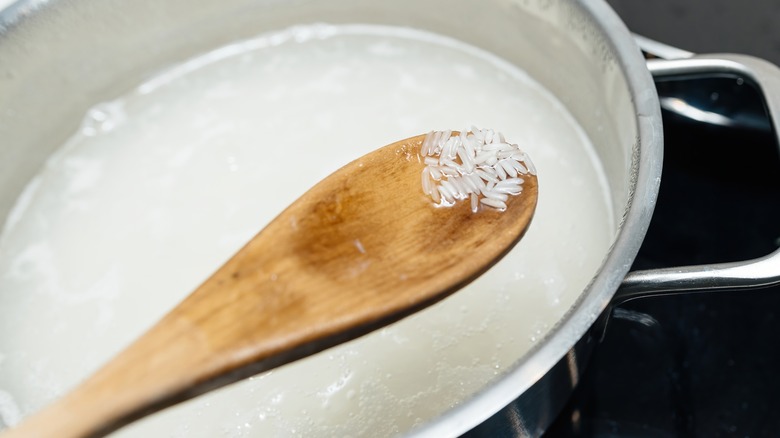You're Rinsing Basmati Rice Wrong According To Padma Lakshmi
Are you rinsing your rice? If not, you should be. A couple cups of rice are an essential component to many delicious dishes. But it's important to pair your proteins and veggies with the best quality rice possible. The first step to tender, fluffy rice starts at the sink. Rinsing your rice helps remove any dirt or unwanted grime picked up on the grains' journey from the ground to your kitchen. Plus, running rice under water also removes starch from the kernels, which is crucial to taste and texture. Too much starch will lead to clumpy rice that is difficult to incorporate into other recipes. Do you really want a dish that's clingy and doesn't play well with others?
To ensure your stews and stir fries are being paired with rice that can rise to the occasion, rinse your rice before cooking it. And that goes every variety of rice — basmati included. According to chef Padma Lakshmi, you probably aren't rinsing your basmati rice correctly. The writer and television host says you should rinse your basmati rice until the water runs clear.
Really rinse your rice
A quick pass under the tap simply isn't enough for rice that won't cluster. The proper process for ridding your rice of some of its starch is actually more time consuming. For the best basmati, Lakshmi says this will require a few thorough washes at the sink, until the cloudy water running off of your rice begins to turn clear (she points out the dense foggy appearance the water will have during the first couple of rinses).
Lakshmi emphasizes that this process could require between three and seven washes. So put on a podcast or cue up a playlist and start the water. In the tutorial posted to her TikTok, Lakshmi doesn't use a strainer or sieve. She simply swishes around her rice in a large mixing bowl full of water, then with the bowl's spout, periodically dumps the liquid out into the sink using her hand to block the grains from spilling out with the overflow.
What are the benefits of bathing your basmati?
Lakshmi says rinsing is the most important part of cooking up a beautiful basmati dish.
The slender grain is an aromatic rice, often associated with jasmine. Aromatic rices possess a floral, nutty quality that can benefit from an additional soak, even after they've been thoroughly rinsed. The compound 2-Acetyl-1-pyrroline is responsible for the signature scent we associate with aromatic rice. A 30-minute soak in tap water will help to preserve this compound and enhance its trademark floral essence and flavor. Well-soaked grains also lead to shorter cook times and softer, more evenly cooked rice.
In most instances, taking a little water to your rice before dropping it in the pot is the way to go. You may want to consider skipping the step when prepping a dish like paella or risotto that requires the grains to stick together, or when cooking with "pre-washed" or "ready to cook" instant rice. So next time you're thinking of skipping the sink, remember to follow Padma Lakshmi's lead for fluffy, flavorful rice.


